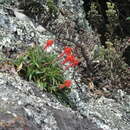Comprehensive Description
provided by Smithsonian Contributions to Botany
Barbacenia luzulifolia Martius ex Schultes f
Barbacenia luzulifolia Martiuus ex Schultes f. in Roemer & Schultes, Syst., 7:285, 1826.—Seubert in Martius, Fl. Bras., 8(1):69, pl. 8: fig. 2, 1847.—L. B. Smith, Contr. U.S. Nat. Herb., 35:280, 1962.—Ayensu, Smithsonian Contr. Bot., 15:65, fig. lo.p, pls. 6c, 47e, 1974.
Aylthonia luzulifolia (Martius ex Schultes f.) Menezes, Ciência e Cultura, 23(3):[421], 1971.
TYPE.—“Villa Ricca” (Ouro Preto), Minas Gerais, Brazil, Martius s n (M, holotype; F, photo 18996).
DISTRIBUTION.—Brazil: Minas Gerais: Caete (Serra da Piedade), Ouro Preto.
56. Barbacenia saxicola L. B. Smith & Ayensu, new species
A B. luzulifolia Martius ex Schultes f., cui parum affinis, appendicibus coronoideis subovatis obtuse lobatis quam antheris subtriplo brevioribus differt.
Caudex at least 4 cm long, covered by reflexed leaf-blades. Leaves sulcate on both sides, viscous; sheaths not visible; blades linear, filiform-attenuate, over 11 cm long, 8 mm wide, laxly setose-ciliate.
Scape single, 11 cm long above the leaf-sheaths, laxly vestite with fine contorted partly tumid-based hairs. Flowers reddish orange (!Anderson et al.), hairy like the scape. Ovary cylindric, 13 mm long, 6 mm wide. Perianth-tube slenderly infundibuliform, blending with the ovary, 45 mm long, 11 mm wide at apex. Tepals lanceolate, 20 mm long, the outer narrow, completely tomentose, the inner broad, tomentose only on the median base. Anthers 15 mm long. Coronoid appendages ovate with short obtuse lobes, 6 mm long. Style not enlarged at apex; stigmas linear, apically confluent.
LEAF ANATOMY (partial leaf specimen) (Anderson et al 35344).—Surface View: Hairs: none observed. Epidermis: cells on both surfaces square to rectangular; thin-walled. Stomata: tetracytic; 21 × 18 μm; present in rows on both surfaces.
Transverse Section of Lamina: Dorsiventral; V-shaped. Both surfaces undulating. Epidermis: cells on both surfaces rounded to dome-shaped; thin-walled. Cuticle: thickened and ridged over entire surface. Stomata: present on both surfaces; stomata sunken below the epidermal surface and flanked by 2 protuberances; substomatal chamber present. Mesophyll: 4 or 5 layers of small palisade cells followed by 6 or 7 layers of rounded, thin-walled cells; many cells appear translucent. Vascular bundles: total unknown; commissural bundles observed. One large vessel present in each bundle. Two phloem units lying laterally in flanges of wide Y-shaped abaxial girder. Thin, inverted Y-shaped adaxial girder present on each bundle. Girders extend to epidermis on both sides. Bundle sheath completely surrounding each bundle. Crystals: few present in mesophyll. Tannins: present, especially in epidermis and bundle sheath.
TYPE.—On rocks (sandstone), cerrado and open hillsides, 8 km north of Gouvêa on road to Diamantina, Minas Gerais, Brazil, 1220 m alt, 4 February 1972, Anderson, Stieber & Kirkbride 35344 (US, holotype; NY; UB, isotypes).
DISTRIBUTION.—Known only from the type-collection.
57. Barbacenia reflexa L. B. Smith & Ayensu, new species
Barbacenia rubro-virens sensu L. B. Smith in Ayensu, Smithsonian Contr. Bot., 15:67, fig. lm, n, 23d–f, 1974 [in part, as to Maguire, Magalhaes & Maguire 49260].
A B. luzulifolia Martius ex Schultes f., cui verisimiliter affinis, foliis scapisque multo majoribus, tepalis angustis reflexis differt.
Caudex (incomplete) over 2 cm long, ca. 2 cm thick with leaf-sheaths. Leaves sulcate on both sides, appearing dry but not certain because of fire damage; sheaths completely covered; blades linear, filiform-attenuate, 25 cm long, 8 mm wide, laxly setose-ciliate near base, otherwise glabrous.
Scape single, 23 cm long above leaf-sheaths, sub-densely brown-tomentose. Flowers mauve-tinged (!Maguire et al.), subdensely brown-tomentose. Ovary narrowly turbinate, 18 mm long, 9 mm wide, narrowly infundibuliform, slightly constricted above ovary, 12 mm wide at apex. Anthers 9.5 mm long; coronoid appendages narrowly subtriangular, acutely bidentate. Style not enlarged at apex; stigmas linear, apically confluent.
LEAF ANATOMY.—Ayensu, Smithsonian Contr. Bot., 15:67, fig. 1m.n, 23d–f, 1974, sub B. rubro-virens.
TYPE.—On sandstone, slopes and summit of Serra Grão Mogul (16°39′S, 42°45′W), Minas Gerais, Brazil, 900–1100 m alt, 17 August 1960, Maguire, Magalhães & Maguire 49260 (US, holotype; NY, isotype).
DISTRIBUTION.—Known only from the type-collection.
Note: This collection was originally determined as B. rubro-virens Martius and may well be more nearly related to that species than our admittedly artificial key indicates.
- bibliographic citation
- Smith, Lyman B. and Ayensu, Edward S. 1976. "A Revision of American Velloziaceae." Smithsonian Contributions to Botany. 1-172. https://doi.org/10.5479/si.0081024X.30
Comprehensive Description
provided by Smithsonian Contributions to Botany
Barbacenia luzulifolia Martius ex Schultes f
SPECIMENS EXAMINED.—Pereira 2664–Pabst 3500.
SURFACE VIEW.—Hairs: none present. Epidermis: cells square to rectangular, few rounded on abaxial and adaxial surfaces; thin walled. Stomata: paracytic, 24 × 9 μm; present on both adaxial and abaxial surfaces.
TRANSVERSE SECTION OF LAMINA.—Somewhat dorsiventral; V-shaped with margins turned slightly inversely. Both adaxial and abaxial surfaces evenly undulating. Epidermis: adaxial cells mostly rounded to dome shaped, few conical; thin walled. Abaxial cells rounded to dome shaped, few elongated; cell walls thicker than adaxial ones. Adaxial epidermal cells larger around midvein. Cuticle: very thin on both adaxial and abaxial surfaces. Stomata: present on both adaxial and abaxial surfaces; substomatal chamber quite large; usually flush with epidermal surface. Mesophyll: three layers of elongated palisade-like cells changing into large, rounded, translucent cells in the mid-region of mesophyll. Vascular bundles: 43; no commissural bundles observed. One to two large vessels present in each bundle, mostly one. Two phloem units lying laterally in flanges of V- or Y-shaped abaxial girder. Inverted Y-shaped adaxial girder present on each vascular bundle. Bundle sheath completely surrounding each vascular bundle. Crystals and tannins: none observed.
- bibliographic citation
- Ayensu, Edward S. 1974. "Leaf Anatomy and Systematics of New World Velloziaceae." Smithsonian Contributions to Botany. 1-125. https://doi.org/10.5479/si.0081024X.15

